文章目录
1 Lambda 表达式
1.1 lambda是一个匿名函数
原先的匿名内部类
//例如 比较器
Comparator<String> com = new Comparator<String>(){
@Override
public int compare(String o1, String o2) {
return Integer.compare(o1.length(), o2.length());
}
};
TreeSet<String> ts = new TreeSet<>(com);
TreeSet<String> ts2 = new TreeSet<>(new Comparator<String>(){
@Override
public int compare(String o1, String o2) {
return Integer.compare(o1.length(), o2.length());
}
});
//现在的 (使用Lambda 表达式)
public void test2(){
Comparator<String> com = (x, y) -> Integer.compare(x.length(), y.length());
TreeSet<String> ts = new TreeSet<>(com);
}
1.2 lambda应用
集合
List<Employee> emps = Arrays.asList(
new Employee(101, "张三", 18, 9999.99),
new Employee(102, "李四", 59, 6666.66),
new Employee(103, "王五", 28, 3333.33),
new Employee(104, "赵六", 8, 7777.77),
new Employee(105, "田七", 38, 5555.55)
);
//需求:获取公司中年龄小于 35 的员工信息
public List<Employee> filterEmployeeAge(List<Employee> emps){
List<Employee> list = new ArrayList<>();
for (Employee emp : emps) {
if(emp.getAge() <= 35){
list.add(emp);
}
}
return list;
}
//需求:获取公司中工资大于 5000 的员工信息
public List<Employee> filterEmployeeSalary(List<Employee> emps){
List<Employee> list = new ArrayList<>();
for (Employee emp : emps) {
if(emp.getSalary() >= 5000){
list.add(emp);
}
}
return list;
}
优化方式1:策略模式 - 匿名内部类
策略类
public interface MyPredicate<T> {
public boolean test(T t);
}
//公共方法
public List<Employee> filterEmployee(List<Employee> emps, MyPredicate<Employee> mp){
List<Employee> list = new ArrayList<>();
for (Employee employee : emps) {
if(mp.test(employee)){
list.add(employee);
}
}
return list;
}
public void test5(){
List<Employee> list = filterEmployee(emps, new MyPredicate<Employee>() {
@Override
public boolean test(Employee t) {
return t.getAge() <= 35;
}
});
for (Employee employee : list) {
System.out.println(employee);
}
}

优化方式2: lamada表达式
public static void test6(List emps){
List<Employee> list = filterEmployee(emps, (e) -> e.getAge() <= 35);
list.forEach(System.out::println);
System.out.println("------------------------------------------");
List<Employee> list2 = filterEmployee(emps, (e) -> e.getSalary() >= 5000);
list2.forEach(System.out::println);
}
优化方式3:Stream API
public static void test7(List<Employee> emps){
emps.stream()
.filter((e) -> e.getAge() <= 35)
.forEach(System.out::println);
System.out.println("----------------------------------------------");
emps.stream()
.map(Employee::getName)
.limit(2)//取前两个
//.sorted()
.forEach(System.out::println);
}
test7(emps);
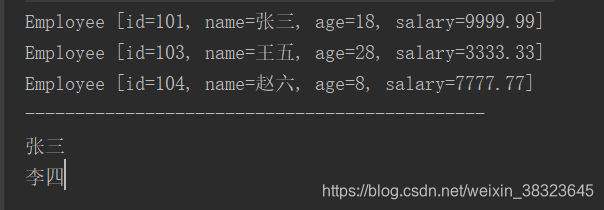
1.3 lambda 语法
语法格式一:接口方法 无参数,无返回值
-
() -> System.out.println("Hello Lambda!");
Runnable r = new Runnable() {
@Override
public void run() {
System.out.println("Hello World!" + num);
}
};
r.run();
System.out.println("-------------------------------");
Runnable r1 = () -> System.out.println("Hello Lambda!");
r1.run();
语法格式二:有一个参数,并且无返回值
-
(x) -> System.out.println(x)
public void test2(){
//java 自带类
Consumer<String> con = (x) -> System.out.println(x);
con.accept("德玛西亚!");
}
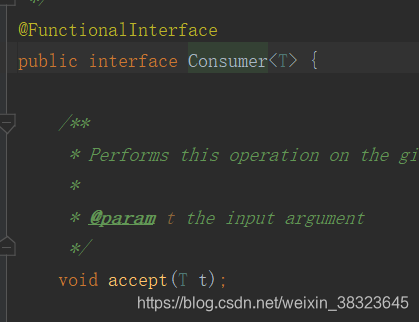
语法格式三:若只有一个参数,小括号可以省略不写
-
x -> System.out.println(x)
public void test2(){
//java 自带类
Consumer<String> con = x -> System.out.println(x);
con.accept("德玛西亚!");
}
语法格式四:有两个以上的参数,有返回值,并且 Lambda 体中有多条语句
Comparator com = (x, y) -> {
System.out.println(“函数式接口”);
return Integer.compare(x, y);
};
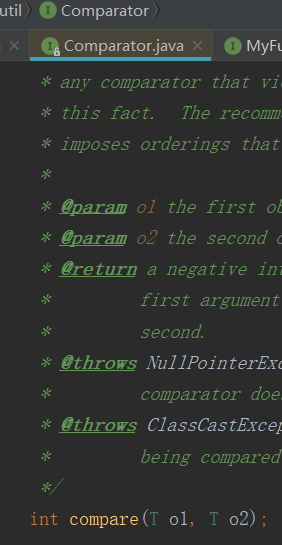
public void test3(){
Comparator<Integer> com = (x, y) -> {
System.out.println("函数式接口");
return Integer.compare(x, y);
};
}
语法格式五:若 Lambda 体中只有一条语句, return 和 大括号都可以省略不写
-
Comparator<Integer> com = (x, y) -> Integer.compare(x, y);
public void test4(){
Comparator<Integer> com = (x, y) -> Integer.compare(x, y);
}
语法格式六:Lambda 表达式的参数列表的数据类型可以省略不写,因为JVM编译器通过上下文推断出,数据类型,即“类型推断”
-
(Integer x, Integer y) -> Integer.compare(x, y);
1.4 Lambda 表达式需要“函数式接口”的支持
- 函数式接口:接口中只有一个抽象方法的接口,称为函数式接口。 可以使用注解 @FunctionalInterface 修饰 修饰完只能有一个抽象方法
练习
先按年龄比 ,年龄一样按姓名比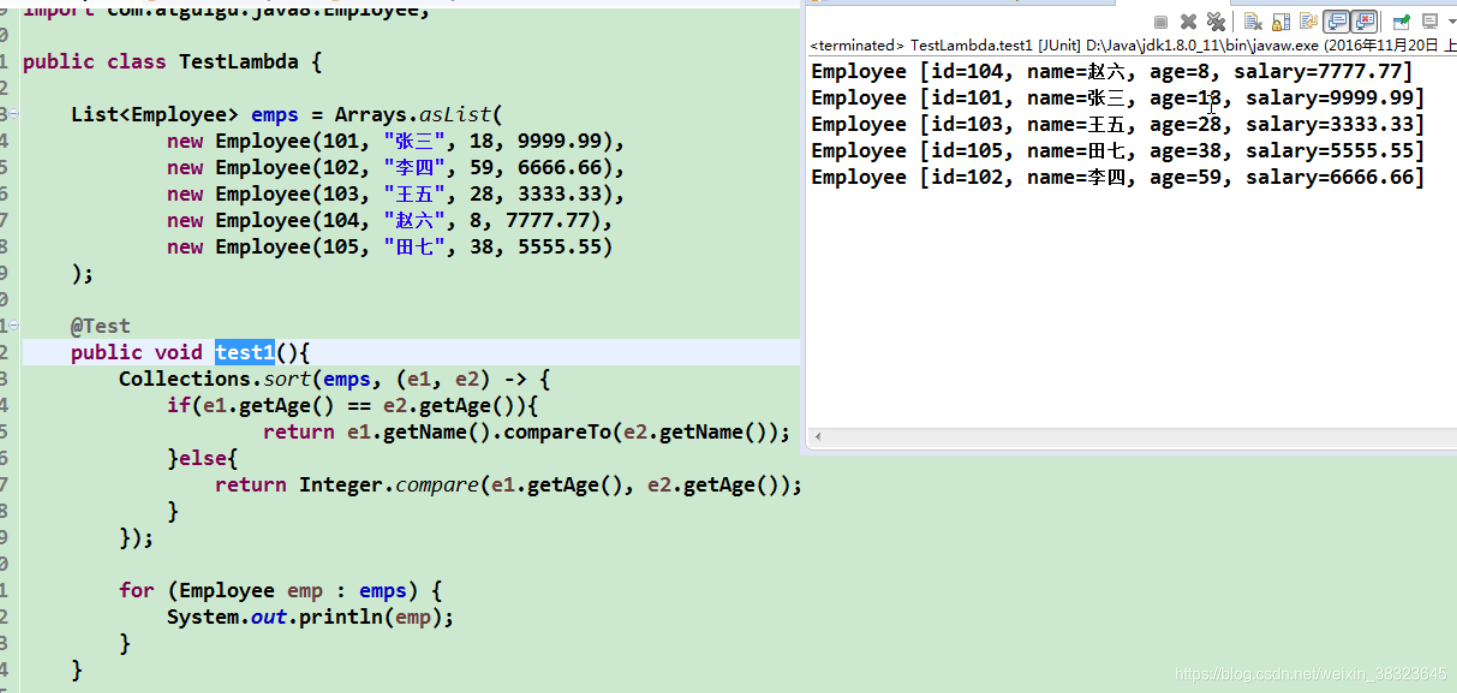
return 负号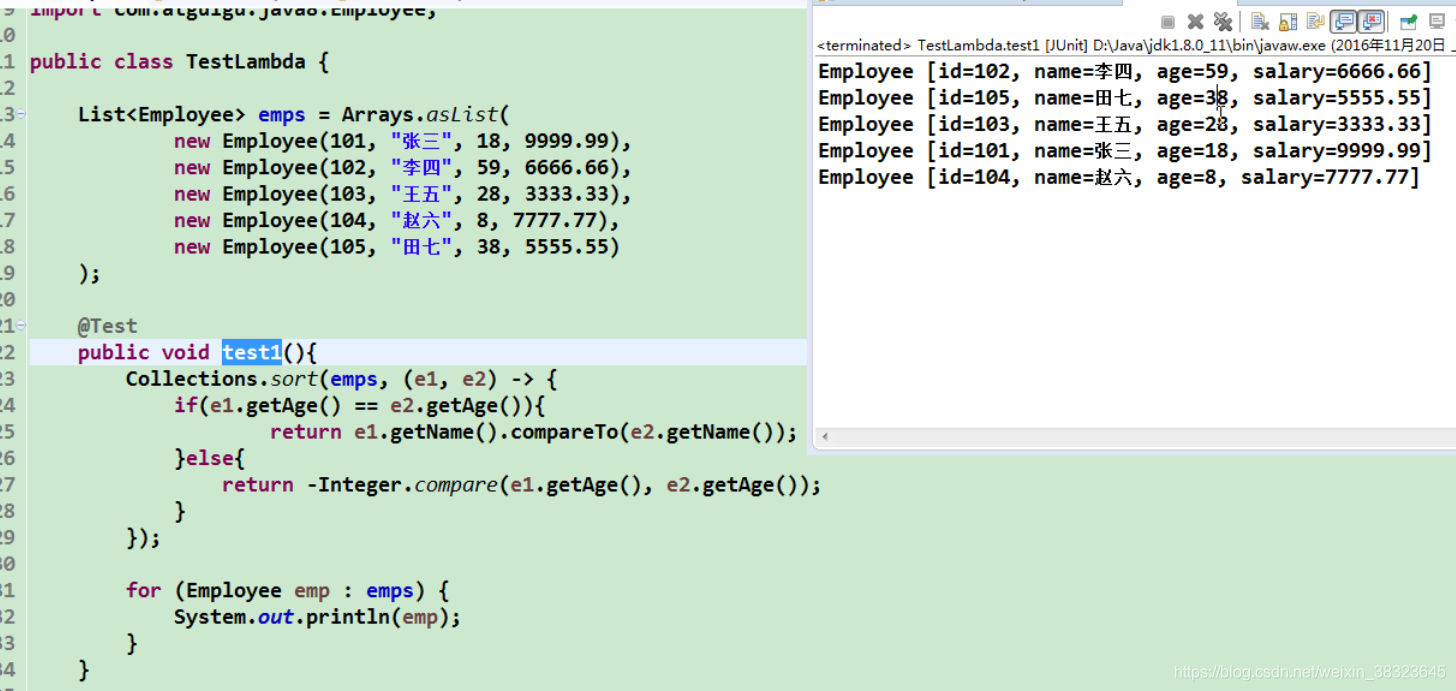
2 函数式接口
public interface MyFunc<T,R> {
public R getVVV(T t1, T t2) ;
}
public class Test2 {
//对两long数据处理
public static void op(Long one,Long two,MyFunc<Long,Long> myFunc) {
System.out.println(myFunc.getVVV(one,two));
}
public static void main(String[] args) {
op(100L, 200L, (x, y) -> x + y);
op(100L, 200L, (x, y) -> x * y);
}
}
3 Java8 内置的四大核心函数式接口
/
* Consumer<T> : 消费型接口
* void accept(T t);
*
* Supplier<T> : 供给型接口
* T get();
*
* Function<T, R> : 函数型接口
* R apply(T t);
*
* Predicate<T> : 断言型接口
* boolean test(T t);
*
*/
消费型接口
//Consumer<T> 消费型接口 :
public void test1(){
happy(10000, (m) -> System.out.println("你们刚哥喜欢大宝剑,每次消费:" + m + "元"));
}
public void happy(double money, Consumer<Double> con){
con.accept(money);
}
供给型接口
//Supplier<T> 供给型接口 :
public void test2(){
List<Integer> numList = getNumList(10, () -> (int)(Math.random() * 100));
for (Integer num : numList) {
System.out.println(num);
}
}
//需求:产生指定个数的整数,并放入集合中
public List<Integer> getNumList(int num, Supplier<Integer> sup){
List<Integer> list = new ArrayList<>();
for (int i = 0; i < num; i++) {
Integer n = sup.get();
list.add(n);
}
return list;
}
函数型接口
//Function<T, R> 函数型接口:
public void test3(){
String newStr = strHandler("\t\t\t 我德玛西亚 ", (str) -> str.trim());
System.out.println(newStr);
String subStr = strHandler("我大盖伦", (str) -> str.substring(2, 5));
System.out.println(subStr);
}
//需求:用于处理字符串
public String strHandler(String str, Function<String, String> fun){
return fun.apply(str);
}
断言型接口
//Predicate<T> 断言型接口:
public void test4(){
List<String> list = Arrays.asList("Hello", "atguigu", "Lambda", "www", "ok");
List<String> strList = filterStr(list, (s) -> s.length() > 3);
for (String str : strList) {
System.out.println(str);
}
}
//需求:将满足条件的字符串,放入集合中
public List<String> filterStr(List<String> list, Predicate<String> pre){
List<String> strList = new ArrayList<>();
for (String str : list) {
if(pre.test(str)){
strList.add(str);
}
}
return strList;
}








 该博客围绕Java8展开,重点介绍了Lambda表达式,包括其作为匿名函数的概念、应用场景、多种语法格式,还指出其需要函数式接口支持。同时阐述了函数式接口的定义,以及Java8内置的消费型、供给型、函数型、断言型四大核心函数式接口。
该博客围绕Java8展开,重点介绍了Lambda表达式,包括其作为匿名函数的概念、应用场景、多种语法格式,还指出其需要函数式接口支持。同时阐述了函数式接口的定义,以及Java8内置的消费型、供给型、函数型、断言型四大核心函数式接口。
















 1037
1037

 被折叠的 条评论
为什么被折叠?
被折叠的 条评论
为什么被折叠?








